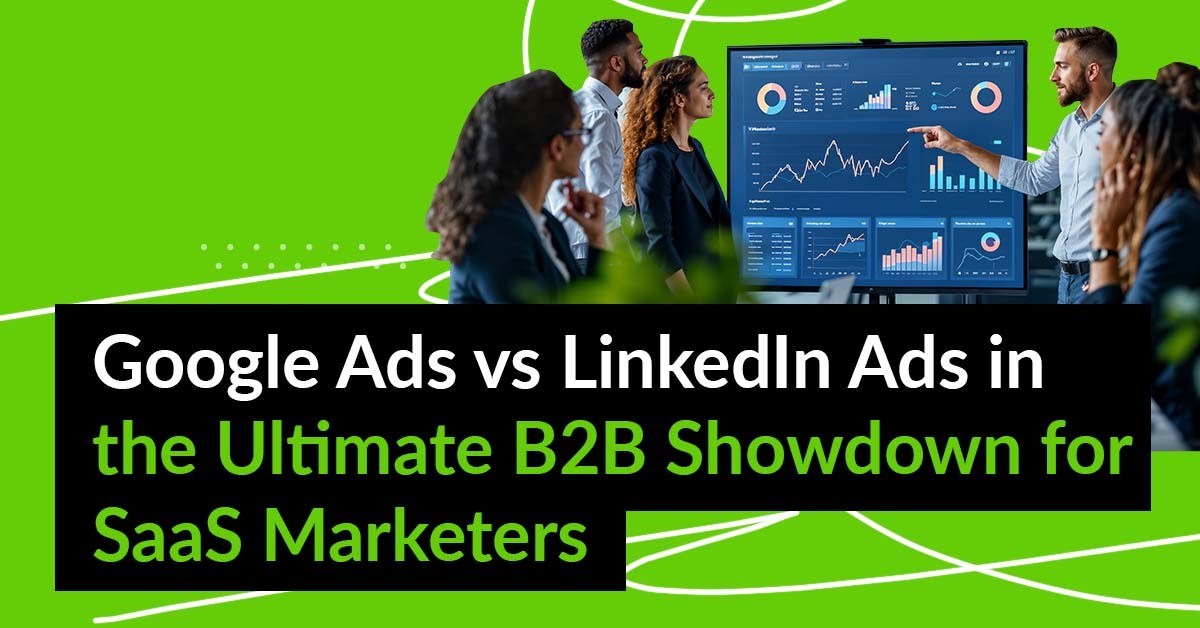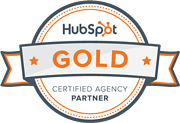What’s the best PPC platform for B2B SaaS companies?
It’s an important question. When it comes to generating leads and driving demand for SaaS companies, choosing the right paid advertising channels can significantly impact your results. Two of the brightest, most popular stars in the ongoing debate about the best channels are, of course, the mighty Google Ads and the more B2B-tailored LinkedIn.
Considering Google Ads vs. LinkedIn Ads for SaaS B2B, each platform has strengths tailored to specific marketing goals. To help you make informed decisions, we've created this comprehensive comparison, exploring costs, targeting capabilities, lead quality, and ideal scenarios for each.
So, let’s get started with a look at which platform is better for lead acquisition and demand generation: Google vs. LinkedIn.
What’s the Difference Between Google Ads and LinkedIn Ads for SaaS?
Before we can decide whether Google Ads vs. LinkedIn Ads for SaaS make more sense for your brand, let’s look at the two individually.
Google Ads for SaaS
Google Ads operates primarily on intent-based targeting, focusing on capturing users actively seeking solutions through keyword searches. When a potential customer types relevant keywords into Google's search bar, targeted advertisements appear prominently, aligning perfectly with user intent. Key campaign types often run by SaaS businesses, both B2B and B2C, include:
- Search Ads: Highly effective for bottom-of-funnel conversions such as demo requests and free trials.
- Display Ads: Useful for brand awareness and retargeting.
- Performance Max (PMax): Automated ads across Google’s network for broader reach.
- YouTube Ads: Engaging video ads for education and awareness.
Google Ads’ strength lies in its ability to efficiently capture highly motivated users ready to take immediate action, such as signing up for demos, trials, or making direct inquiries. Consequently, it serves as an integral component of a robust SaaS Google Ads strategy focused on bottom-of-funnel (BOFU) conversions, with solid conversion rates.
LinkedIn Ads for SaaS
LinkedIn Ads, as one might expect from a professional-aligned social network, leverage the vast amount of professional information in users’ accounts. Advertisers can target users based on professional attributes such as job title, seniority, industry, and company size. This precision is particularly advantageous for B2B SaaS advertising channels, aligning well with top-of-funnel (TOFU) and middle-of-funnel (MOFU) campaigns.

While LinkedIn often has a higher cost per lead (CPL), the precision of targeting generally yields more qualified B2B leads, making it valuable for LinkedIn lead generation for software companies.
Google Ads vs LinkedIn Ads: Which Has Better Cost?
When comparing LinkedIn Ads vs. Google Ads for B2B, one of the first and most important things to consider is cost. How much does it cost to get a potential lead on one platform vs. the other?
Generally, Google Ads campaigns offer lower average CPC, ranging between $3–$10. This makes Google Ads accessible for broader campaigns and scales effectively with high-volume search queries.
LinkedIn, however, commands a premium price due to its detailed professional targeting, with average CPC typically between $6–$15. While this is obviously higher, LinkedIn’s higher CPC often corresponds with significantly improved lead qualification and relevance. Yes, you might spend more upfront, but these leads typically represent higher lifetime value (LTV) opportunities and justify a greater customer acquisition cost (CAC) investment.
For SaaS solutions with complex, enterprise-level offerings, high-value sales, or long-term subscription models, LinkedIn’s precise professional targeting helps justify its higher CPC and CPL by delivering leads likely to convert into more profitable, long-term customers.
CAC vs. LTV – What Do They Mean?
Customer Acquisition Cost (CAC) refers to the total cost of acquiring a new customer, including marketing expenses, sales processes, and operational costs. Lifetime Value (LTV) measures the total revenue a business expects to earn from a single customer over time. Balancing CAC and LTV is crucial for SaaS businesses: if your CAC is significantly lower than your LTV, your campaigns are financially sustainable and profitable. Aligning CPC and CPL with CAC and LTV helps ensure that your advertising strategy remains efficient, scalable, and profitable in the long run.
Google Ads vs. LinkedIn Ads: Which Platform Offers Better Targeting for SaaS Companies?
For SaaS businesses, especially those targeting B2B buyers, ad platform targeting can make or break your campaign results. Choosing between Google Ads and LinkedIn Ads isn’t just about cost or reach; it’s about how effectively you can get your message in front of the right buyers, at the right stage of their journey, and with the right intent.
How Google Ads Targeting Works for SaaS
Google Ads’ targeting revolves around user intent. When someone types “best ERP software for manufacturers” or “marketing automation tool for small business” into Google, they’re signaling clear purchase or research intent. Google allows you to reach these prospects through several sophisticated tools:

- Keyword Match Types: Control when your ad shows up based on the exactness of the search term. For example, phrase and exact matches help you zero in on high-value, bottom-of-funnel buyers, while broad match can help with awareness for newer SaaS categories.
- Custom Intent Audiences: Build audiences based on specific search behaviors or website visits. For SaaS, this means targeting users who have recently researched your competitors or engaged with similar software categories.
- Demographic & Location Filters: Layer in basic demographic (age, location) and device targeting to further refine your audience, ensuring you’re reaching business buyers in your ICP’s most relevant regions.
- Remarketing and Customer Lists: Reach users who’ve already visited your website, trialed your product, or interacted with your brand elsewhere on the web. Remarketing in Google Ads for SaaS can be a game-changer for bringing warm leads back into your funnel.
Google’s real power is in its ability to harness intent data at scale, allowing SaaS businesses to “harvest” existing demand for their solution, especially when buyers are ready to compare, request a demo, or start a free trial.
How LinkedIn Ads Targeting Works for SaaS
LinkedIn’s greatest strength for SaaS marketers is its unmatched ability to target users by professional and firmographic criteria. Rather than targeting based on what someone is searching for, you’re targeting who they are and where they work — perfect for B2B SaaS.
- Job Title, Function, and Seniority: Want to reach CMOs at tech companies, HR managers at enterprises, or IT directors at SaaS startups? LinkedIn allows you to filter by exact titles, functions, and seniority levels, which is ideal for niche SaaS tools with specific buyers.
- Company Industry, Size, and Name: Focus your campaigns on industries that align with your solution (finance, healthcare, technology), filter by company size to prioritize enterprise or SMB, or upload target account lists for account-based marketing (ABM).
- Skill and Group Targeting: Reach users based on skills listed in their profiles (e.g., “Salesforce,” “AWS,” “cybersecurity”) or by professional group memberships, helping you hone in on tightly defined technical audiences.
- Matched Audiences and Lead Gen Forms: Retarget people who have visited your site, engaged with your content, or are in your CRM, then drive conversions with seamless, pre-filled lead gen forms.
This ability to hyper-segment is why LinkedIn is a dominant player for B2B SaaS advertising channels, especially for products with a complex buying committee or long sales cycle.
Things to Consider for SaaS Marketers
- Lead Quality: LinkedIn’s targeting often produces fewer, but more qualified, B2B SaaS leads — key for high-ACV or enterprise SaaS solutions. Google, meanwhile, may deliver a higher lead volume, especially for self-service SaaS, but sometimes with wider variation in quality.
- Remarketing and Layering: Both platforms allow for sophisticated remarketing, but combining their audiences (e.g., LinkedIn account targeting layered with Google retargeting) can improve efficiency at every funnel stage.
- Ongoing Optimization: Both require regular review — keyword refinements on Google, audience exclusions and job title tweaks on LinkedIn — to ensure you’re consistently hitting your ideal customer profile.
When it comes to targeting options, LinkedIn vs. Google Ads clearly give an edge to LinkedIn’s edge for niche B2B segments and account-based marketing (ABM). However, Google’s wide reach and intent-based targeting is a strong showing in its own right.
Lead Quality in Google vs. LinkedIn for SaaS
When it comes to paid media for SaaS lead generation, there’s very little that matters more than lead quality. Google's intent-based approach generates high-conversion leads, often ready for immediate action. Conversely, LinkedIn's professional targeting typically produces leads with higher qualification but potentially longer sales cycles.
Google Ads Offer High Intent
Leads generated through Google Ads typically have a high degree of commercial intent. These are people who are actively searching for a solution — maybe even yours — right now. When a prospect types in “best CRM for financial services” or “enterprise project management software demo,” they’re signaling a clear intent to learn, evaluate, or even buy. This makes Google Ads particularly effective at driving direct conversions, trial sign-ups, demo requests, or even inbound sales calls.
- Shorter Sales Cycle: Because these users are often further along in the B2B SaaS buyer journey, they may require less nurturing and convert more quickly from MQL to SQL and then to customer.
- Varied Lead Quality: However, the open nature of Google’s search also means you might attract leads outside your ideal customer profile (ICP). Some may be too small, unqualified, or just browsing for information.
- Scalability: Google Ads can produce a higher volume of leads, which is great for SaaS products with broad appeal and self-serve models. But it may also mean more time spent by your sales team qualifying and disqualifying leads.
LinkedIn Ads Offer High-Value Leads
LinkedIn Ads excel at putting your brand and content in front of exactly the right people: your ideal customers, at specific companies, with the right job titles and seniority. This is invaluable for B2B SaaS companies targeting niche industries, specific company sizes, or complex buying committees.
- Marketing-Qualified Leads (MQLs): LinkedIn’s detailed professional filters mean you’re more likely to attract high-value, relevant leads — people who fit your ICP and can influence a buying decision. These may be heads of IT, VPs of Finance, or Operations Directors at companies in your target vertical.
- Longer Sales Cycle: Because LinkedIn campaigns often focus on TOFU and MOFU activities (e.g., content downloads, webinar signups, guide requests), these leads tend to enter your funnel earlier and require nurturing before they’re ready for sales outreach.
- Higher Conversion Rate to Opportunity: While you may see fewer leads from LinkedIn compared to Google, those that do come in are typically much more likely to become opportunities, reach a sales conversation, and progress to closed-won — especially for enterprise and high-ACV SaaS solutions.
- Lead Quality and LTV: LinkedIn leads, thanks to their strategic targeting, often correlate with higher average contract values (ACV) and longer customer lifetimes. This is especially important for SaaS models focused on long-term retention and expansion.
To sum up, intent-driven platforms like Google typically shorten sales cycles, whereas LinkedIn's targeted leads may require additional nurturing but offer superior long-term ROI.
When to Use Google Ads vs LinkedIn Ads in Your SaaS Funnel
Effectively leveraging each platform requires a strategic alignment with your funnel stage, campaign objectives, product type, and overall marketing strategy.
Best Use Cases for Google Ads
Google Ads is exceptionally effective for bottom-of-funnel (BOFU) activities aimed at capturing immediate interest and converting leads into customers:
- Immediate Conversions: Google’s Search Ads are highly effective at capturing users explicitly searching for solutions. Campaigns focused on terms like “best SaaS software for project management” or "CRM software demo" can swiftly convert users into trial sign-ups or booked demos.
- Branded Searches and Competitor Targeting: Google Ads lets SaaS businesses capture traffic searching specifically for their brand or competitors’ brands, effectively diverting high-intent traffic towards their solution.
- Retargeting Campaigns: Users who visit your site but don't immediately convert can be effectively recaptured through Google’s Display and Remarketing Ads, dramatically increasing conversion rates by continually engaging interested visitors throughout their decision-making process.
- High-Volume, Scalable Campaigns: If your SaaS product appeals to broad markets or has high search volumes, Google Ads provides a scalable solution to efficiently capture extensive market demand, making it ideal for widespread brand exposure.
Best Use Cases for LinkedIn Ads
LinkedIn Ads offer unmatched potential for strategic SaaS marketing at the upper and middle parts of the funnel:
- Thought Leadership and Content Marketing: LinkedIn excels in promoting whitepapers, case studies, and webinars. Ads targeting professionals based on their job functions or seniority effectively draw in relevant audiences, building your brand's credibility and engaging decision-makers early in the funnel.
- Account-Based Marketing (ABM): LinkedIn’s powerful targeting capabilities make it ideal for precise ABM campaigns. Targeting specific companies, job titles, or roles enables focused marketing strategies, directly influencing decision-makers and stakeholders within key accounts.
- Niche Product Launches and Market Testing: LinkedIn is particularly valuable for SaaS companies launching niche products. Its detailed targeting helps identify and reach highly specific audiences, making it ideal for market validation and targeted promotions, reducing the risk associated with new product introductions.
- Lead Generation and Form Ads: LinkedIn’s native Lead Gen Forms simplify the user experience, significantly boosting form-fill rates by pre-populating user data, streamlining the capture of highly qualified leads directly within the platform.
- Nurturing and Retargeting with Matched Audiences: Using LinkedIn’s Matched Audiences, marketers can effectively retarget website visitors, event attendees, or CRM contacts, nurturing them further down the funnel through tailored messaging and follow-up campaigns.
LinkedIn vs. Google Ads for SaaS: Pros and Cons Summary Table
|
Aspect |
Google Ads |
LinkedIn Ads |
| Targeting | Intent-driven (keywords, search behavior) | Professional attributes (job title, industry, company size) |
| Funnel Stage | Bottom-of-funnel (BOFU) | Top-to-middle funnel (TOFU/MOFU) |
| Cost per Click (CPC) | Lower ($3-$10) | Higher ($6-$15) |
| Lead Quality | Immediate intent, quicker sales cycle | Higher qualification, longer sales cycle |
| Ideal Use Cases | Capturing immediate demand (demos, trials), branded search, retargeting. | Building awareness, thought leadership, ABM, niche product launches. |
| Scalability | Highly scalable with search volume | Scalable for targeted B2B audiences, can be constrained by niche size |
| Ad Formats | Search Ads (Text), Display Ads (Image), Video Ads (YouTube), Performance Max | Image, video, carousel, document, text, lead gen forms |
| ROI Measurement | Direct conversion tracking, often tied to immediate sales/leads. | Requires longer-term tracking, multi-touch attribution, CRM integration for full value. |
Conclusion: Is LinkedIn or Google Better for B2B SaaS?
Ultimately, the debate over Google Ads vs LinkedIn Ads for SaaS doesn’t end with a single winner; it’s about understanding how each platform can play to your strengths at different points in the customer journey.
Google Ads shines when you need to capture high-intent, in-market buyers who are already searching for solutions like yours. Partnering with a Google Ads agency can amplify these efforts by optimizing campaigns for lower CPC, scalability, and efficiency at the bottom of the funnel—making it the best engine for immediate lead capture, demo requests, and trial sign-ups. If your SaaS business thrives on search volume, well-defined keywords, and rapid sales cycles, Google Ads can consistently deliver a strong, cost-effective flow of new leads.
LinkedIn Ads, meanwhile, offers unmatched precision for targeting decision-makers, influencers, and key accounts — especially in complex or high-value B2B sales. While the CPC and CPL may be higher, the quality and relevance of leads are often far superior. LinkedIn marketing services further amplify these benefits by helping businesses craft and execute strategic campaigns that align with their goals. LinkedIn excels at building awareness, nurturing prospects through educational content, and executing highly targeted ABM strategies that move large deals forward, even in industries with long, intricate buying cycles.
However, the most successful B2B SaaS marketers are those who recognize this isn’t an either/or question. You can use both platforms, letting each serve an ideal role — LinkedIn for top-of-funnel awareness and relationship building, Google for bottom-of-funnel intent capture and conversion — to let you cover the full spectrum of the B2B buyer journey.
The real winners will be SaaS companies who embrace the strengths of both Google Ads and LinkedIn Ads — combining intent and precision, scale and specificity, for full-funnel, sustainable growth. These shouldn’t be seen as competitors as much as they should be seen as a dynamic duo: Use LinkedIn Ads for top-of-funnel brand awareness and Google Ads for bottom-of-funnel lead capture.
Do you want a marketing partner who can help you master the intricacies of both Google Ads and LinkedIn for B2B SaaS marketing? SevenAtoms is an experienced digital marketing agency with a proven track record of helping our clients — B2B SaaS or otherwise — find success on LinkedIn and Google Ads.
Contact us today for a free consultation. We can help you master both LinkedIn and Google Ads for your SaaS business!
.jpg?width=860&height=258&name=Ready%20to%20choose%20the%20best%20ad%20platform%20for%20your%20SaaS%20growth_%20(1).jpg)









